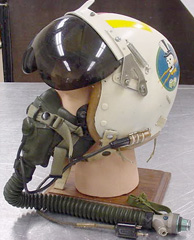 |
US Military Aviation
Flight Helmets
USAF late 40s-50s |
 |
The development of Jet aircrafts during the late 40s led to understand that the flight headgear used so far on propeller aircraft was not any more suitable to adeguatelly protect the pilots during the new typic flight and combact performances of the jet aircrafts.
In particular the increasing noise of the aircraft engine and the utilization of ejection seat system at higher speeds and altitudes led to the development of rigid shell helmet which provided much more noise attenuation as well as head protection in case of high speed bail-out or an emergency crash.
After the early non standardized "Transitional" helmet the first standard issue Air Force Helmets were of the P series from P-1 to P-4B. At the end of the 50s a new helmet design was introduced: the APH-2 with its innovative visor mechanism and relevant protective housing.
Early "transitional" rigid flight helmets
During the late 40's the early rigid flight helmets were still not standardized, some of those were customized by the pilots themself or constructed by private aircraft company personnel for their own use. These "transitional" helmet were manufactured using elements coming from WW II softs flight headgear modified with rigid parts coming from helmets used on army tanks, race-cars, or football game.
Even as these "transitional" helmets were finding application in the first US jet, research on hard protective helmets incorporating communications and oxygen mask attaching system, was being conducted by the Air Force's Wright Patterson Personal Equipment Laboratory (PEL), Clothing Branch, under the umbrella of the Engineering Division of the Material Command, Northrop Aviation's Dr. Charles Lombard, and Private companies such as Consolidated Vultee Aircraft Corporation in San Diego, California. these research bring to development of the ancestors of the early standard flight helmets.
Modified tank helmet:
On April 19, 1945 Air Corps Maj. Carl Arnold of the TSEAL-5C (Clothing Branch) were requesting tank helmets, ordnance G-9, for PEL. They were an interim measure to be used for developmental work for use as crash helmets for the Air Corps. The development work on crash helmets (modified G-9 tank helmets) for use in the Lockheed XP-80 project was accomplished by the PEL in conjunction with the plastic division of the Continental Can Company, Inc. Chicago, Illinois. On January 8, 1946 a report from the AAF Board did not recommend the modified tank helmet for standardization but it continued in service for a while yet until replacements were available.
Style 1 helmet:
By July 5, 1945 the Chief of Material Division sent another developmental sample protective helmets developed by Captain J.F. Hooper of the PEL to the AAF Board, Orlando, Florida.
By October 1945 Mr. Lagrand Daly of the Paramount Rubber Company was sending another new type of helmet mold for evaluation at the PEL. As we can see many helmets were being tested at the same time by the PEL. Meanwhile by Oct. 31, 1945 Col. Haskins was sending a developmental helmet sample to the Chief Test Pilot, Jack Wodams of the Bell Aircraft Corporation in Buffalo, New York, for the XS-1 project. Also Tony LeVier, Chief Test Pilot of the Lockheed Aircraft Corporation in Burbank, California, received one.
In a letter of the 29 April 1946 the designation STYLE 1 was coined to the new helmet that the PEL has developed. Seventy-five were forward to Randolph Field Texas for evaluation in the P-80 type aircraft. Individual fitting of these helmets to students and instructors range in head sizes from the smallest required size up to approximately size 7-3/8 may be fitted. It is suggested the following method of fitting be used in order to provide the greatest comfort and protection to each individual. The Bell Company were conducting a series of experiments with the XP-83 aircraft and made a series of recommendations by A.M. Johnston, Chief test pilot, to the Material Command (PEL) in modifying the Style 1 after an accident on Sept 4, 1946 by Mr. C.L. Fay. Among the recommendations were the built –in earphones, insufficient lamination in the helmet shell and a corner of approximately 70 degree angle in the crown and back drop edge. Because the Style B helmets were under development no changes would be done to the Style 1 helmet according to the reply from PEL.
Style B helmet:
As mentioned above On January 8, 1946 a report from the AAF Board did not recommend the modified tank helmet for standardization. February 7, 1946 the PEL asked a number of companies to fabricate a helmet (the one that would later be designated Style B). This new helmet has a shell moulded from laminated 8 ounce enamelling duck impregnated with phenolic resin. The shape is similar to that of a football helmet which provides maximum coverage of the head, consistent with good visibility, head movements, goggle type B-8 and oxygen mask integration. The outside surface is a metallic copper spray, applied by scuffing the surface and painting with a mixture of clear lacquer and brilliant copper flake powder, which has a high thermal insulation value. This finish is easily scratched, but is not inclined to chip off as readily as the electro-plated copper finish. Space within the helmet provide for air circulation. The edge of the shell, has a plug strip of ¼ inch thick foam rubber cemented to the inside adjacent to the edge, is bound with 1/8 inch diameter rubber tube which has been split length-wise and a 1/32 inch thick strip of Buna sheeting. Included in the binding around the corners of the flaps are cut-to-shape neoprene sheeting for retaining the earphones mounting.
Style B-1 helmet:
By July 29, 1947 the Paramount Rubber Company was manufacturing the B-1 flying helmet. Despite the fact that a test preliminary report had not been received from NACA, orders of production and distribution had already started. Pre-standardization testing would be conducted by Air Proving Ground Command, Florida and deliveries expected to start approximately in July 15, 1947. Due to the urgent requirement existing for head protection to pilots of high speed aircraft, this helmet was initially distributed to the AAF Fighter units. On 20 August of 1947 a letter was sent to the Commanding General, Army Air Force, Washington D.C., Research and Engineering Division from Colonel Arnold T. Johnson, Air Corps, Chief, Engineering Standards Sections, Engineering Division for the ´ Authority for Change of Status of Equipment´ now then P-1 (Does this mean that the STYLE B-1 was standardised as the P-1?). Standardization took effect on September 1947.
|
|

|
Early post-war USAAF jet helmet from 71th Fighter Interceptor Squadron, 1st Fighter Group which was based at March Field, California, flying F-80. It is based on a Wilson leather football helmet painted red with 71 FIS decals on
each side. (Bluelight) |
|
| Early USAAF jet helmet from 71th Fighter Interceptor Squadron. It was equipped with a November 1944 dated A-14 oxygen mask and British-made Mk. VIII flying goggles. (Bluelight) |

|

|
|
|

|
P-80 test pilot Capt. Martin L. Smith from the Flight Test Division at Wright Field was one of three pilots who participated in the transcontinental speed run (L.A. to N.Y.) on 28 January 1946. Posing before departure, he is wearing a British WWII glider helmet based on the Type C. (USAF and Best of Flightgear) |
| USAF F-84C pilot wearing a US steel helmet over his cloth flying helmet. (USAF and Best of Flightgear) |
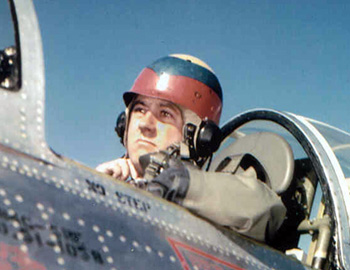
|

|
Eugene "Gene" May, chief test pilot of Douglas Aircraft Corporation, wearing a "pudding basin" helmet. The pudding basin designation is just a description based on its appearance, not an official one. Others including Lockheed test pilot, Anthony LeVier, have used this type of helmet as well. (USAF and Best of Flightgear) |
Lockheed test pilot, Anthony "Tony" LeVier, wearing what appears to be a British Type C helmet with a "pudding basin" hard top attached to it.
(USAF and Best of Flightgear) |

|

|
P-80 Test pilot wearing a late 40s "transitional" flight helmet probably coming from a modified 1938 tanker helmet and A-13A oxygen mask. (NACA) |
| USAF F-80 pilots wearing tanker helmets of slightly different configuration. (LIFE and Best of Flightgear) |

|

|

|
Replica of an USAF late 40s "transitional" flight helmet based on USAAF AN-H-15 WWII soft helmets and custom fit tanker helmet upper hardshell. (Jürg Kühni) |
| Replica of USAF 1946 "transitional" flight helmet based on USAAF A-11, AN-H-15 WWII soft helmets and vintage US Army tanker helmet. (DocBoink) |

|

|

|
Capt. John S. Babel's modified tank helmet made by a rigger at Muroc. Capt. John S. Babel from 412th Fighter Group, was another of the three pilots who participated in the transcontinental speed run on 28 January 1946. His helmet is now part of the National Air and Space Museum collection (Best of Flightgear) |
| Very interesting replica of USAF late 40s "transitional" flight helmet based on US Army tanker helmet. (Maggot and Blaster) |

|

|

|
Prototype protective helmet developed by Captain J.F. Hooper at the Materiel Division. The two pictures show the hard shell attached to a Type A-11 Intermediate Flying Helmet. (USAAF and Best of Flightgear) |
| Helmet made by Stefan Cavallo, test pilot for the National Advisory Committee for Aeronautics (NACA) at Langley Field, Virginia. Constructed from a fibre glass miner's helmet and portions of a summer flying helmet. This helmet have to be considered almost certainly an early version of the Style 1 helmet. (Best of Flightgear) |

|

|

|
USAF Style 1 Protective Flight Helmet manufactured and patented by Cairns, attached to AN-H-15 Flight Helmet with special added snaps, circa 1945.
(Bellsaviation.com) |
| Capt. William Gates, 36th Fighter Group, and Major Jay Robbins, 1st Fighter Group, wearing Style 1 helmets over A-11 leather helmets.(LIFE and Best of Flightgear) |

|

|
1.Lt Robert Drew, 1st Fighter Group, wearing a Style 1 helmet over an A-11 leather helmet.
(LIFE and Best of Flightgear) |
USAF P-80 pilot in 1948 with a modified tanker helmet over an A-11 leather helmet
(USAF) |

|

|
USAF pilot Jack Woolams in the Bell XP-77 with interim flight helmet customized from a football leather helmet |
Colonel Albert Boyd (later major general), chief of the Flight Test Division at Wright Field, Ohio, seen on 19 June 1947 after he set a new world speed record of 623.738 miles per hour in an XP-80R over Muroc. Co. Boyd is wearing what is assumed to be a Style B helmet.
(USAF and Best of Flightgear) |

|

|
Colonel Albert Boyd with a Style B helmet. The oxygen mask attachment studs are visible on the outside of the helmet shell on both sides along the face opening. The helmet also has a chin strap with chin cup. The angular shape of the helmet is also notable in this photo. (USAF and Best of Flightgear) |

|

|
Don Hillman and G.I. Ruddell of the 94th Fighter Squadron during P-80 cold weather trials at Ladd AFB wearing a Style B-1 helmets
(USAF and Best of Flightgear) |
| 1946 Dr. lombard early flight helmet prototype. The development of this early model later evolved in the top tex style helmets |

|

|
Probable late 40s "custom-built" Protection Incorporated style flight helmet. (Figmo) |
| USAF pilot Paul Tibbets wearing a "custom-built" Protection Incorporated style flight helmet or an early version of TOP TEX. (USAF) |

|

|
USAF "custom-built" Protection Incorporated style flight helmet or an early version of TOP TEX retrofitted with P-3 style visor. |
| Unusual USAF helmet which shows a mix of features between the P-1 helmet and the early Dr. Lombard style helmet. It could be a Wright Aero Lab experimental prototype of the P-1 helmet, incorporating Dr. Lombard helmet features, or an experimental collaboration between Dr. Charles Lombard and the Wright Aero Lab (at Wright-Patterson AFB, Ohio). (Doc Boink) |
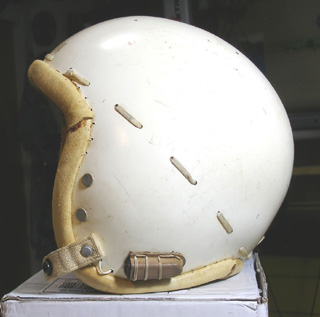
|

|
| Another specimen of the USAF helmet which shows a mix of features between the P-1 helmet and the early Dr. Lombard style helmet. |

|

|

|
USAF Florida ANG pilots with 1 st generation 1946-47 hard hat flight helmets. Early jet flight helmets were built from mining hard hats or army helmets and these types are shown here. Some are attached onto top of ANH-15 cloth flight helmets. The pilot in middle with a moustache has a rare experimental B-1 flight helmet, predecessor to the P-1 series. All have A-14 oxygen masks.(USAF)
|
| USAF P-80 pilots in 1946-1947 with different type of early transitional hard hat flight helmets.(LIFE) |

|

|

|
USAF "custom-built" Protection Incorporated style flight helmet or an early version of TOP TEX belong to Test pilot Bill Mornville. (Bell's Aviation Museum) |
| Test Pilot Glenn Bach wearing a "custom-built" Protection Incorporated style flight helmet or an early version of TOP TEX (USAF) |

|

|

|
Beautiful specimen of early USAF rigid flight helmet used on P-80 during the late of the 40s. Note the A-14 oxygen mask with the special fitting used for emergency oxygen bottle connection. |
| Very interesting early USAF rigid flight helmet customized from a leather football helmet (Tim Mackie) |

|

|
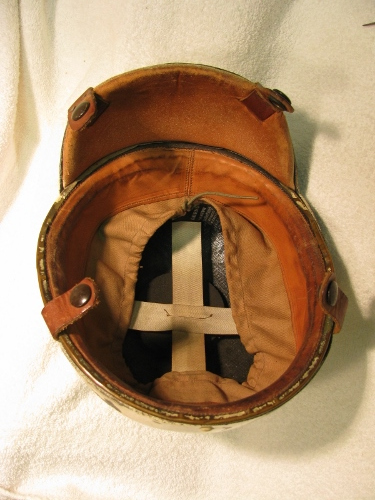
|
Another Beautiful specimen of USAF Style 1 Protective Flight Helmet manufactured and patented by Cairns, attached to AN-H-15 Flight Helmet with special added snaps. |
| Another beautiful early USAF rigid flight helmet customized from a tanker helmet (WW2AWARTOBEWON.COM) |

|
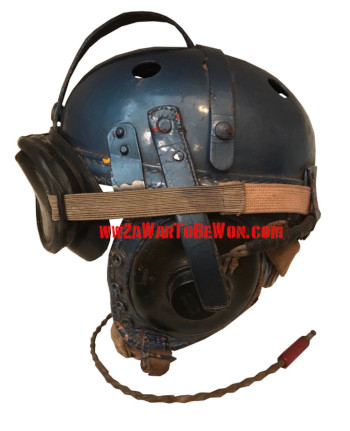
|

|
P-80 test pilot during the late of the 40s with a "transitional" flight helmet probably made using a US steel helmet over his cloth flying helmet. |
| Rare early USAF rigid flight helmet "style B-1" helmet used during the last of the 40s. From this type of helmet was developed the P-1. |

|

|

|

|
Dr. lombard flight helmet or early Top Tex retrofitted with P-3 style visor (ima-usa.com). |
| Internal view of the same helmet. It was very likely used by a Northrop Test Pilot during the early of the 50s (ima-usa.com). |

|
| Same Dr. Lombard helmet with MS22001 Oxygen mask (Cèdric collection). |

|

|

|

|
Another interesting specimen of Dr. lombard flight helmet or early Top Tex retrofitted with P-3 style visor used during the early 50s by a test pilot on B-45 and F-89 Scorpion (MM-05 & KM-06). |
| Another well preserved Dr. Lombard or early TOPTEX flight helmet used during the late of the 40s early 50 (Steve Norris Collection) |

|

|
Test pilot in front of the XB-51 in 1949 wearing a probable B-1 helmet (USAF) |
| Beautiful Dr. Lombard or early TOPTEX flight helmet used by a test pilot during the late of the 40s early 50 |
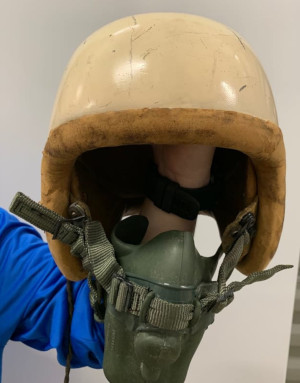
|

|

|
Northrop Test pilot Charles Tucker with Dr. Lombard helmet in 1948 during his flight on X-4 Bantam (USAF) |
 |
P-1
The P-1, introduced in 1948 and made by Switlik Parachute Co. and Paramount Rubber Co. was the first USAF standard hard flight helmet for fighter aircraft. The P-1 initially used the type HS-38 headset, somewhat later changed to HS-38A.
The P-1 shell was constructed of pressure and heat molded laminated cotton duck fabric that had been saturated with phenolic-resin (similar to Bakelite). This helmet did not have a fixed (rivetted) chin strap as did later upgraded versions, but instead could be secured to the head through use of a chin cup that snapped onto the lowest of the snaps on the oxygen mask mounting tabs. A-13A or A-14 oxygen mask were worn together the P-1 as well as black rubber goggles B-8. |
|
| P-1 flight helmet with A-14 oxygen mask and boom mounted microphone. (DocBoink) |

|
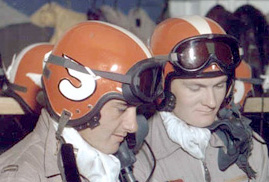
|
USAF Pilots from 82nd FS, 78th FW, Hamilton AFB, CA, flying F-84 Thunderjet in April-May 1950 wearing decorated P-1 flight helmet. (USAF)
|
| Henry A. Siblay Jr. gets final instructions from Capt. Willard U. Hodges before take-off on training flight. Williams AFB, Chandler, Arizona, December 1951. Both the pilots are wearing painted P-1 flight helmets. (USAF) |

|

|
USAF P-1 flight helmet retrofitted with P-3 style external visor. |
| Test pilot in front of the XB-51 in 1949 wearing a probable P-1 helmet (USAF) |

|

|

|
Another beautiful USAF P-1 flight helmet retrofitted with P-3 style external visor. |
| Very interesting USAF P-1 flight helmet shown in the movie The Hunters. |

|

|
USAF P-1 flight helmet of the early 50s with B-8 goggles. (USAF) |
| USAF experimental 1950s flight helmet design which was looking possibly at full face seal. This prtotype seems based on a P-1 flight helmet seen by the black edgeroll. |

|

|

|
USAF pilot Maj Richard Johnson with P-1 helmet during the 1949. |
| Beautiful specimen of USAF P-1 helmet. (Tim Mackie) |

|

|
P-1A ; P-1B
The P-1A adopted in 1949 was basically an advanced version of the P-1 with introduction of a fixed chin-strap, addition of a nape-strap, attachment of the HS-38 headset with Nylon cord. A further modification involved upgrading of the oxygen mask leather attachment tabs. Ruber farmed goggles of the B-8 type were normally used with the The P-1A which in some cases has been later retrofitted with P-3 style visor. The P-1A was utilized with A-13A and A-14 oxygen mask.
The P-1B flight helmet was identical in all respect to the P-1A. it was only created through a change in designation nomenclature. |
|
| USAF P-1A flight helmet with B-8 goggles and A-13A oxygen mask. |

|

|
USAF Fully decorated P-1A with A-13A oxygen mask (Maggot). |
| USAF P-1A dated 1952 retrofitted with P-3 style visor. |

|

|
Lt. William Starr on T-33 wearing a P-1A and A-13A oxygen mask (John Starr). |
| Very interesting specimen of USAF P1A flight helmet. (Trixum.de) |
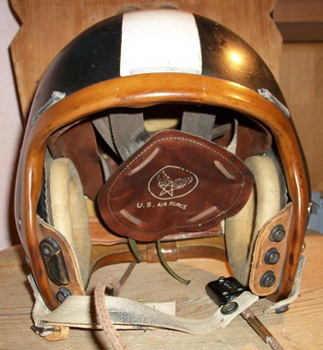
|

|

|
USAF P-1B. It is impossible to distinguish the P-1B from a late P-1A without looking at the manufacturer's paper
label inside the helmet shell. (Best of Flightgear) |
| Possible P-1A flight helmet experimentally modified with face plate and unusual oxygen mask probably for high altitude helmet evaluation and test. (USAF) |

|

|
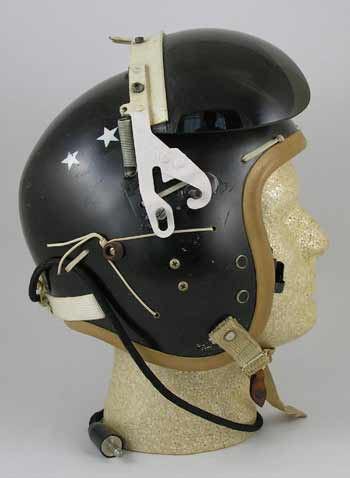
|
USAF P-1B retrofitted in P-4 type flight helmet (Bellsaviation.com) |
| Beautiful USAF P-1A in the color of the Thunderbirds aerobatic team |

|

|
 |
P-2
The P-2 was a limited, non-standard research prototype designed and developed by Wright-Patterson Aircrew Equipment Laboratory based on the US NAVY H-3 and H-4 helmets approach of utilizing a soft fabric inner helmet to hold the communications headset under the hard protective shell. The P-2 utilized a P-1A hard shell over a conventional USAAF type AN-H-15 khaki poplin soft helmet. Presumably also the headset was identical to that used with the AN-H-15 helmet. Otherwise, the outer rigid shell features the same conventional design of leather/nylon head suspension system, fitted to accomodate the slightly extra protusive of the inner soft helmet. Because this helmet was very rare and almost none official informations are available some experts are of the opinion that the P-2 was actually the first P-helmet type fitted with a fixed visor. |
|
| P-2 entire hard/soft shell ensemble with A-13A oxygen mask. (USAF) |

|

|
P-2 inner soft helmet showing the wiring loom arrangement for the earphones. (USAF) |
| Reconstruction of P-2 composite flight helmet with AN-H-15 as a communication assembly, over which a P-1A shell is fixed, and to which the A-13A oxygen mask is snap-fitted. (DocBoink) |

|

|
USAF flight helmet with head internal sling labeled as P-2 and unusual visor latch mechanism. This helmet was more likely originaly a P-1 that was modified to P-1A then P-2 (Bones) |
| USAF P-2 hard shell.The P-2 utilized a P-1A hard shell over a conventional USAAF type AN-H-15 khaki poplin soft helmet and relevant communication assembly and headset. |

|

|

|

|
USAF Pilots of the 4 FIW during the 1950 with probable P-2 helmets. The soft internal helmet is visible on the side of the external rigid P-1 shell |
| USAF Pilots Lt Col Emmert from 4th FIW wearing a probable P-2 helmet composed by a P-1 flight helmet shell over a inner soft helmet in the 1950. (USAF)
| 
|

|
Well preserved USAF P-2 helmets composed by the soft internal helmet and the external rigid P-1 shell (Tim Mackie) |
P-3
The USAF P-3 flight helmet standardized in 1951 was developed to add wind-blast and sun-glare protection to the P-1 style helmet. In this helmet the old B-8 rubber framed goggles were replaced by a new rigid, side-latch actuated external visor assembly designated as PN 51C3632.
The P-3 helmet was virtually identical to the P-1a for most part and only the new rigid external visor distinguished the P-1A series from the P-3 series. This helmet used the HS-38 and HS-38A communication headset assembly and type U-75/U connector plug.
|
|
| USAF P-3 helmet manufactured by Bassons Industries with A-13A oxygen mask (Maggot). |

|

|
USAF P-3 with A-13A oxygen mask. (Bluelight) |
| USAF P-3 manufactured by Selby Shoe Co. dated 1954 with oxygen mask A-13A. (Maggot) |
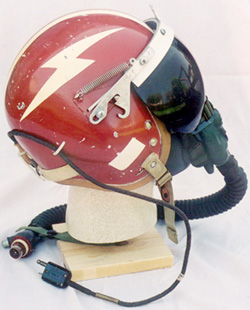
|

|
USAF P-3 with A-13A oxygen mask and visor cover. |
| USAF P3 in the color of the Skyblazers Aerobatic Team used on F-86F during the middle of the 50s |

|

|

|
USAF P3 of the early 50s (Franco Fissore collection) |
| USAF P3 in the color of the 93rd Fighter Sqdr 15th FIS during the middle of the 50s |

|

|

|

|
Beautiful USAF P3 in the color of the 343rd Fighter Sqdr during the middle of the 50s |
P-4
The USAF P-4 flight hemet was standardized in 1955 as a continuation of P-3 with improved avionics in order to make helmet headset communications and oxygen mask dynamic microphone compatible with aircraft intercommunicationsset AN AIC-10. the new H-75/AIC headset system was added as well as a new earphone cushionsspring mounted and tethered to short nylon strings which protruted through the lateral helmet walls to be secured over a rubber over a rubber lock-nut and snubber bar.The P-4 was used with A-13A/MS22001 A-14 oxygen mask. |
|
USAF P-4 manufactured by Selby Shoe Company with oxygen mask A-13A.
|

|

|
USAF P-4 with color marking of 57th F.I.S. (DocBoink) |
| P-4 helmet from 3600th Combat Crew Training Wing. with oxygen mask A-13A. (Bluelight) |

|
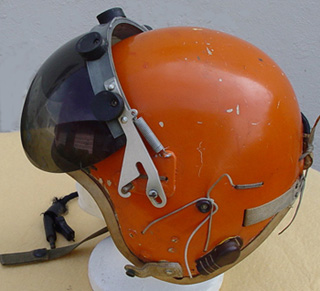
|
USAF P-4 customized with rubber bumpers on the visor frame installed to avoid potential scratches on canopy in case of contact with the helmet's metallic frame. |
| Well preserved USAF P-4 with oxygen mask MS 22001 (Michel Sol) |

|

|

|

|
USAF P-4 (originally it was a P-3 later converted in P-4) in the color of the USAFE Acrojets Aerobatic Display Team used on T-33A during the middle of the 50s |
 |
P-4A ; P-4B
The P-4A standardized in 1957 has a new visor mechanism that replace the side latching design with a tracked visor securing system actuated by grasping a central rubber knob and pulling the visor down into position. The newly assembled P-4A helmets made use of the new fiberglass shell material that replaced the earlier phenolic resin and moled cotton duck material.
In 1959 the P-4B helmet specification was issued which replaced the old "Pigtail" communication cord with a new assembly designated CX-4708/AIC. This allowed the entire earphone and mask microphone communications system to be integrated into the aircraft radio and intercom system via the oxygen mask communication cord H-149/AIC. The P-4A and P-4B were used with MS22001 or MBU-3/P oxygen mask attached to the snaps on lateral leather tabs which was later replaced by Hardman external oxygen mask "Christmas tree" receivers. |
|
| P-4A helmet from 20th TFW manufactued by Selby Shoe Company. (Maggot) |

|

|
USAF P-4A with oxygen mask MS22001. Note the typical visor mechanism.
(Schiffer publishing Ltd.) |
| USAF P-4B with external boom mounted microphone. |

|

|
Late 50s P-4B retrofitted with Hardman external oxygen mask "Christmas tree" receivers. (Schiffer publishing Ltd.) |
| USAF P-4A with visor protective cover and MS22001 oxygen mask. |
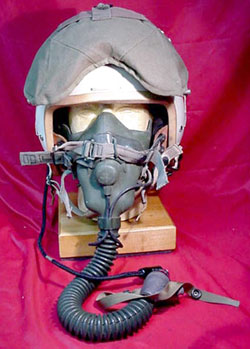
|

|
1959 P-4B with MBU-3/P oxygen mask, Hardman external "Christmas tree" receivers and clear visor. |
| 1958 P-4B retrofitted with TOPTEX style visor track and MBU-3 oxygen mask. This helmet has the USN VF(AW)-3 logo so more likely it was used by a USN pilot flown in a USAF aircraft. |
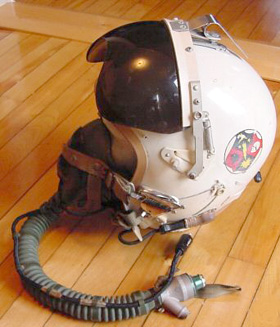
|

|
1957 P-4A or P-4B retrofitted with early type of oxygen mask straight bayonet receivers. |
| Very beautiful USAF P-4A or P-4B flight helmet and MS22001 oxygen mask |

|

|

|

|
Another interesting USAF P-4A or P-4B flight helmet with clear visor and MS22001 oxygen mask |
| Very beautiful USAF P-4A flight helmet and MS22001 oxygen mask (Michel Sol) |

|
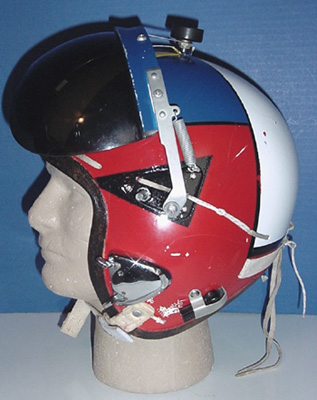
|

|
Awesome USAF P-4B flight helmet with hardman oxygen mask receivers used during the late of the 50s |
| USAF P-4B flight helmet with unusual customized white edgerol and internal foam paddings. |

|

|
Douglas "windblast" helmet
For the flight test on experimental jet aircraft Douglas X-3 Stiletto the Douglas commpany designed a slotted helmet to assure a better protection during the emergency escape from aircraft flying at supersonic speeds. The slots reporyedly reduce windshock and airlift and keep the helmet on the pilot's head. |
|
Douglas experimental "windblast" slotted helmet used during the 50s on X-3 Stiletto
|

|

|
Douglas "windblast" experimental helmet with MS 22001 Oxygen mask in the configuration used on flying test on X-3 Stiletto |
Douglas "windblast" experimental helmet worn during X-3 ejection seat test.
|

|
 |
A-13
The A-13 was intended for use in multi-engine and "low & slow" aircraft. It was used in the mid 1950s on B-36 Peacemaker and the B-29 bombers. The A-13 original version featured the HS-38 headset & chamois-covered earphone cushions (identical to early P-1 and P-3 helmets) and was constructed of a light to medium brown leather. The later version was constructed of gray leather and used the H-75/AIC type headset identical to that in the P-4 hardshell helmet.This helmet was utilized with A-13A or A-14 oxygen mask.
|
|
| USAF A-13 leather helmet with G-2 sunglasses and A-13A oxygen mask. (Schiffer publishing Ltd.) |

|
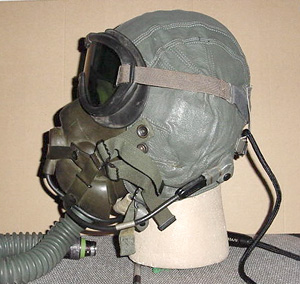
|
USAF A-13 helmet with MBU-4/P oxygen mask and B-8 goggles. |
 |
"Bill Jack" Model D-8/D-10
In the mid 50s the Bill Jack Scientific Instrument Co. developed a flight helmet shell used for different typology of flight helmets. Some of these like the SPH-1 and SPH-2 were intended for use on rotary-wing aircraft. some "Bill Jack" design shell helmets retrofitted with P style visor were also used on jet aircraft. These typology of flight helmets was later manufactured by others company as CalMil, Flight Sound, Protection inc. taking the designation of D-8 and D-10. These flight helmets incorporate the communication earphone and in the early version an external row of snaps of each side of the shell (later replaced by bayonet retainers) to accomodate the oxygen mask. |
|
"Bill Jack" design Model D-10 flight helmet with external boom mounted microphone.
|

|

|
"Bill Jack" design Flight Sound helmet D-10 with external upper sun visor similar to the one also used on USAF helmet HGU-9/P |
"Bill Jack" design Model D-8 flight helmet with the logo of the USAF 343rd Reconnaissance Squadron as used during the middle of the 50s. The helmet is equipped with oxygen mask MS22001 .
|

|
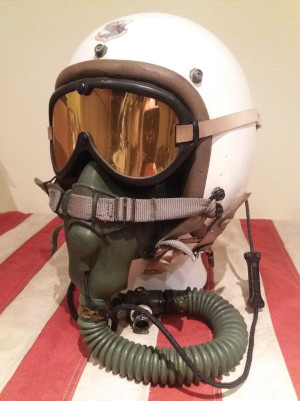
|

|
USAF "Bill Jack" design Model D-10 flight helmet with MS22001 oxygen mask used by SAC during the 50s (Niki Helsen). |
| USAF "Bill Jack" design Model D-10 flight helmet with Sierra Model 249 oxygen mask during the late of the 50s. This experimental mask was the precursor of the MBU-5/P. |

|
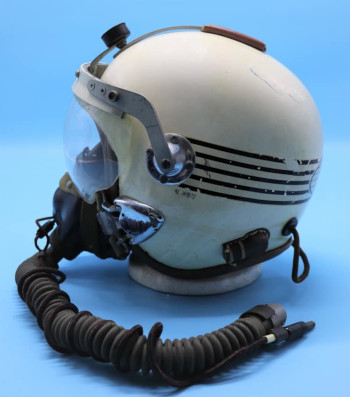
|
"Bill Jack" design flight helmet with TOPTEX style visor. This helmet belong to test pilot Al White and it was also used during his flight on XB-70 Valkirie (San Diego Air and Space Museum). |
A-13
The A-13 was intended for use in multi-engine and "low & slow" aircraft. It was used in the mid 1950s on B-36 Peacemaker and the B-29 bombers. The A-13 original version featured the HS-38 headset & chamois-covered earphone cushions (identical to early P-1 and P-3 helmets) and was constructed of a light to medium brown leather. The later version was constructed of gray leather and used the H-75/AIC type headset identical to that in the P-4 hardshell helmet.This helmet was utilized with A-13A or A-14 oxygen mask.
|
|
| USAF A-13 leather helmet with G-2 sunglasses and A-13A oxygen mask. (Schiffer publishing Ltd.) |

|

|
USAF A-13 helmet with MBU-4/P oxygen mask and B-8 goggles. |
 |
DH-41
The Gentex DH-41 was a prototype helmet intended for use in multi-engine and "low & slow" aircraft. It was used for some flight test by USAF during the 50s as for instance by the crew involved in the aerospace research parabolic flights. This helmet was compoused by a cloth inner helmet incorporating the communication system attached by screws to an upper fiberglass hard shell with the suspension system. The advanced versions of this early prototype were named DH-41-1 and DH-41-2 and have been used by the Candian Air Force in several type of aircraft including high performance fighters.
|
|
| DH-41 Gentex helmet evaluated by USAF during the 50s |

|

|

|
The DH-41 helmet was compoused by a cloth inner hemet and an upper fiberglass hard shell. |
| DH-41 helmet with MS22001 oxygen mask. The mask suspension is a PATE suspension, as used in Canada on DH-412 helmets. (Tim Mackie) |

|

|

|

|
Probably early DH-41 helmet with P-4 Style communication equipment and fitted with external boom microphone. |
MB-3
The MB-3 made by Aviators Equipment Corporation, was used by Strateguc Air Command in the late 50s early 60s for crew positions not requiring use of a rigid helmet.This hemet was constructed of a laminated inner shell covered in white leather. The MB-3 was utilized with MS22001, MBU-4/P and MBU-5/P oxygen mask. |
|
USAF MB-3 with B-8 goggles and MBU-4/P oxygen mask. (Schiffer publishing Ltd.)
|

|

|
USAF MB-3 with MS22001 oxygen mask. Note the flexible bill attached to the helmet. |
USAF MB-3 with the insigna of the Startegic Air Command
|
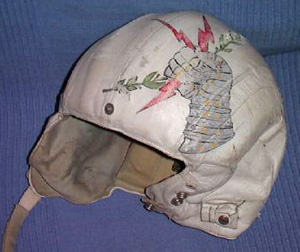
|

|
USAF MB-3 with A-14A oxygen mask and the flexible bill attached to the helmet. |
USAF MB-3 with MS 22001 oxygen mask and Nuclear Flash goggles (Niki Helsen)
|

|

|
Unusual MB-3 retrofitted with US Navy APH-5 visor system (Steven Wilson). |
 |
MB-4
The MB-4 was identical to the P-4 except that it lacked the rigid external visor.This helmet was intened for use in non-high performance aircraft, such as slower, multi-crewed bombers, transport, and utility aircraft, in which the extra protection of a wind-blast visor was not needed.
Although the rigid wind-blast visor was not standard to the MB-4 specification, the external visor P-4A style was frequentelly added. The MB-4 was utilized with MS22001, MBU-3/P and MBU-5/P oxygen mask. |
|

|
USAF MB-4 flight helmet with B-8 goggles and MS22001 oxygen mask |
USAF MB-4 flight helmet made by Selby Shoe Company with MBU-3/P oxygen mask. This specimen has been retrofitted with P-4A style external visor and Hardman external oxygen mask "Christmas tree bayonet" receivers. (Schiffer publishing Ltd.)
|

|

|
USAF MB-4 helmet with leather tabs for oxygen mask and P-4A style external visor |
USAF MB-4 flight helmet with MBU-3/P oxygen mask. This specimen has been retrofitted with Aluminum cast external oxygen mask receivers.
|

|

|
Well preserved specimen of USAF MB-4 helmet with leather tabs for oxygen mask. |
 |
TOPTEX and 4AM SUPER TOPTEX
The TOPTEX flight helmet produced by Protection Inc. Division of Mine Safety Appliance Company was typically used by Test pilots since the middle of the 50s through the 70s, as well as in some USAF squadrons. This helmet has the unique and typical external visor locking mechanism with cental track and do not utilize the chin stap. In the TOPTEX early configuration the external visior was not present and the oxygen mask was secured to the snaps on leather tabs replaced in the later versions by Hardman external oxygen mask "Christmas tree bayonet" receivers. External boom mounted microphone, clear visor or customized mask receivers were in some cases also installed.
The 4AM SUPER TOPTEX was developped during the 80s by Protection Inc. and Gentex as a lightweigh variant of the standard TOPTEX. It had only 4 layers of fiberglass while the standard shell has 8. The SUPER TOPTEX was also normally equipped with bungee visor or HGU-53/P style visor |
|

|

|
Early type of TOPTEX flight helmet still without external visorwith and MS-22001 oxygen mask (Bell's Aviation Museum) |
| Convair Engineering Test Pilot B.J. Long wearing an early configuration of TOPTEX flight helmet with external visor. Note the external boom mounted microphone and the oxygen mask fixation snaps on leather tabs. (Convair) |

|

|
TOPTEX flight helmet with clear visor and Hardman external oxygen mask "Christmas tree bayonet" receivers |
USAF TOPTEX in the color of the Thunderbirds acrobatic team in 1959 with MBU-3/P oxygen mask.
(Schiffer publishing Ltd.) |

|
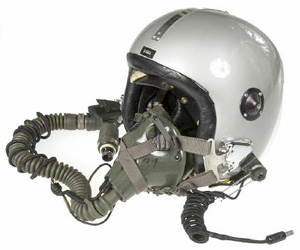
|
TOPTEX with external visor removed and oxygen mask MBU-5/P. (Figmo) |
| TOPTEX customized with unusual "Two on each side" oxygen mask receivers and MBU-3/P oxygen mask modified with the relevant four small bayonets. |
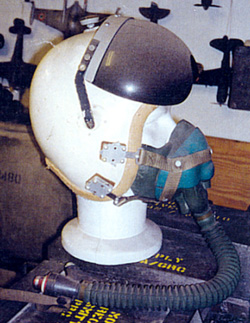
|
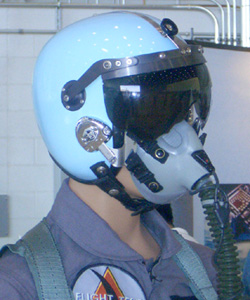
|
TOPTEX with MBU-12/P oxygen mask used by a Northrop/Grumman test pilot at Edwards AFB.
(John Fischer) |
| TOPTEX flight helmet with Aluminum cast bayonet receivers. |

|

|
Awesome chrome finished TOPTEX manufactured by Protection Inc. with christmas tree bayonet receivers and MBU-5/P oxygen mask used by USAF pilot during the 60s.
|
| TOPTEX flight helmet used during the beginning of the 60s with early type of straight bayonet receivers and MBU-5/P. |

|

|
TOPTEX flight helmet with MBU-3/P oxygen mask. Note the visor trimmed in the lower parts in order to get a better fit with the oxygen mask profile. (Nick/flightgear.ch) |
| TOPTEX flight helmet used during the 50s with lateral leather tabs and snaps for mask retention and MS22001 oxygen mask. |

|
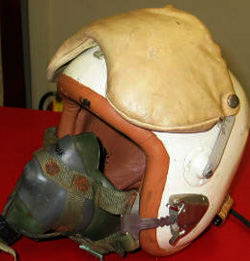
|

|
TOPTEX flight helmet with MBU-3/P oxygen mask and external visor leather protective cover. Normaly in the TOPTEX no chin or nape straps were installed |
| TOPTEX flight helmet with external boom mounted microphone and visor modified to accomodate the MBU-5/P oxygen mask profile. (Steadheads) |

|

|

|
Late 50s TOPTEX flight helmet with early type of MBU-5/P oxygen mask |
| TOPTEX flight helmet used during the 70s-80s with with Aluminum cast bayonet receivers |

|

|

|
TOPTEX flight helmet with trasparent visor and MBU-3/P mask. This specimen is displayed at Edwards AFB museum |
| Beautiful example of TOPTEX flight helmet used during the middle of the 60s with MS22001 Oxygen mask equipped with US Navy pressure regulator and REDAR hose |

|

|

|
Awesone black painted TOPTEX flight helmet used by the famous test pilot Henry Jones |
| 3BM TOPTEX flight helmet with A-13A Oxygen mask used during the early 60s by McDonnell Test pilot Maj. Robert L. Sharp |

|

|

|

|
Late 50s TOPTEX flight helmet with early type of visor knob (Bellsaviation.com) |
| early 50s TOPTEX flight helmet with A13A oxygen mask (Bellsaviation.com) |
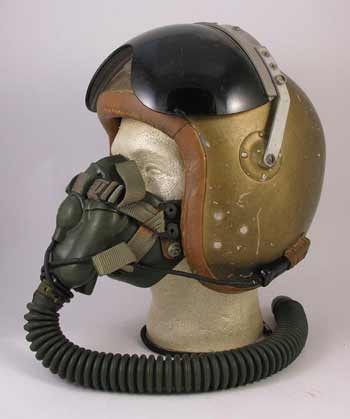
|

|

|

|
Other awesome late 50s TOPTEX flight helmet in the color of the USAF Thunderbirds aerobatic team. |
| Early type TOPTEX flight helmet retrofitted with P-4 external visor. This helmet was used by a Lockheed Test Pilot during the middle of the 50s. |

|
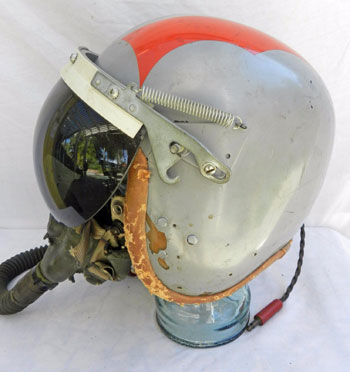
|
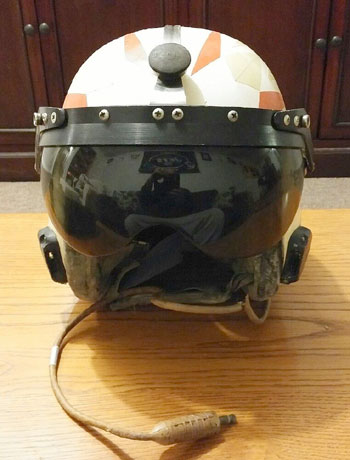
|

|
Interesting middle 60s TOPTEX flight helmet with early type of straight bayonet receivers. Because of its avionic and general design it was very likely used on US Navy aircrafts. |
| Beautiful USAF camouflage painted TOPTEX flight helmet used by USAF Pilot Lt Col Mopkins on F-5A Freedom fighter during the Viet-Nam war in the middle of the 60s |
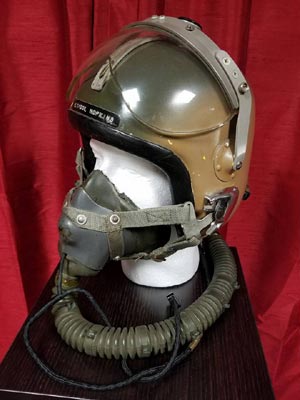
|

|

|

|
Very beautiful TOPTEX flight helmet with MS22001 Oxygen mask and REDAR Hose. This helmet belong to Test Pilot Frank "Pete" Everest. He hand painted this helmet with a native American head dress. This helmet was worn by Everest when he served as Chief of the Air Force Test Flight Section at Edwards AFB during the late of the 50s. |
| Other awesome USAF TOPTEX flight helmet in the color of the USAF Thunderbirds aerobatic team and Oxygen Mask MBU-3/P mask used during the late 50s |

|

|

|

|
Interesting middle 50s USAF TOPTEX flight helmet. |
| Gentex 4AM SUPER TOPTEX flight helmet with bungee visor (Philippe Tondeur collection) |

|

|

|

|
Same SUPER TOPTEX worn by Test Pilot Paul Metz for ATF-23 program (Philippe Tondeur collection). |
4AM Super TopTex flight helmet modified with HGU 55/P style visor and experimental oxygen mask which seems to have both similarity with MBU-14/P and MBU-23/P.
|

|
 |
DH-5 / DH-5-3
The DH-5 was developed by Gentex in the mid 50s as USAF version of the US Navy DH-5-3 to replace the P-4, P-4A and P-4B in the USAF inventory. Its shell was constructed of a fiberglass cloth reinforced with epoxy resin and internal suspension system adjustable by external straps was used. The DH-5 incorporates the earphone so no internal cloth helmet was used, the oxygen mask was secured to fast snap bottoms on external leather tabs. The external visor was moved and secured by means of two lateral tracks system. The USAF chose the HGU-2/P so this helmet never reached the operational service. |
|
Gentex DH-5 with later type of external visor. The visor was secured by two unique design lateral tracks.
|

|

|

|
The DH-5 internal suspension system was adjustable by two external straps. |
| DH-5 Flight helmet worn for a seat ergonomic test in an USAF test facility or laboratory during the middle of the 50s . |

|

|

|
USAF DH-5-3 with early type of external visor. This specimen was probably tested with the throat laryngophone communication system |
| USAF DH-5-3 Flight helmet, this specimen is equipped with P-4 style avionics and ear pads . |

|

|

|
USAF DH-5-3 tested during the middle of the 50s |
 |
HGU-2/P
The HGU-2/P was the first USAF helmet incorporating the visor housing. Its shell was constructed of a fiberglass cloth reinforced with epoxy resin. The HGU-2/P incorporate the H-149/AIC headset identifiable by the MX-2088/U earcup, the double nylon sting attachment and the microphone plug hanging loosely from the side of the helmet. The HGU-2/P was used with MS22001 or MBU-3/P oxygen mask which was attached to snaps on leather tabs on HGU-2/P early configuration, Hardman "Christmas tree bayonet" or straight T bayonet receiver have been installed in the later version whose were mainly utilized with MBU-5/P oxygen mask.The neutarl grey or trasparent visor was moved and locked in the early HGU-2/P by a round knob incorporating a push buttom locking device, classical "star" locking knob was present in the later configuration. |
|
Early configuration of HGU-2/P of the late 50s with leather oxygen mask tabs and push buttom visor lock knob. (Bluelight)
|

|

|
USAF HGU-2/P with Hardman "Christmas tree bayonet" receivers and oxygen mask MBU-5/P. |
| USAF HGU-2/P with straight T bayonet receivers and oxygen mask MBU-5/P with early configuration of suspension straps. (Schiffer publishing Ltd.) |

|

|

|
USAF HGU-2/P modified for use in Stategic Air Command. The visor system has been removed and three snaps over the face opening added in the typical configuration of other SAC flight helmet like the HGU-9/P. (Figmo and DocBoink) |
| USAF HGU-2/P with Hardman "Christmas tree bayonet" receivers external boo bounted microphone and oxygen mask MBU-5/P. This HGU-2/P was modified with anusual red leather custom fit edgeroll and internal liners. |

|

|
USAF HGU-2/P with MBU-5/P (Chameloon) |
| USAF HGU-2/P with straight bayonet receivers and oxygen mask MBU-5/P. |

|

|

|
Very interesting early HGU-2/P with black edge roll, visor type with hooked-edge with the associated L-bracket stops, P-4 style of earphone mounting, but instead of the brown phenolic-colored cord studs like the P series, it appears to have the later HGU nickel snap studs as used on the later HGU-2A/P.The chin and nape straps appear to be USN APH types, also the the liner is very unique, using a blue surface material.
This helmet very likely represent the earliest version of HGU-2/P helmet customized with some later elements like the Christmas tree bayonet recivers and the chin and nape straps.
|
| Very beautiful USAF HGU-2/P in the color of the 20th TFW flying the F-100 in Wethersfiedl AFB during the late 50s.
| 
|

|

|

|
Interesting USAF HGU-2/P with MS22001 Oxygen mask of the late 50s.
|
| USAF HGU-2/P with MS22001 Oxygen mask used by F-104A pilot in 1961.
| 
|
|
















































































































































































































































